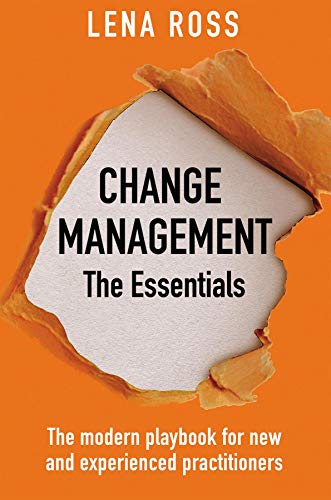Change Management: The Essentials

It’s hard to figure out what you need to know for change management. It’s such a big profession with so many overlapping definitions that it’s hard to sort out what might be the essentials. That’s what makes Change Management: The Essentials such a difficult thing to pull off. Lena Ross doesn’t score a perfect 10 for this work – but it’s a good way to get oriented quickly if you’d like.
Will and Skill
Change management requires both will and skill. You can’t easily teach will. Will is the grit and tenacity that it takes to succeed in difficult situations. (See Grit for more on what grit is.) However, as Willpower explains, willpower can be developed over time. By testing and retesting our will – and persevering through challenges – we grow stronger. (See Antifragile for more.) C.R. Snyder in The Psychology of Hope explains that hope has two components: willpower and waypower. Waypower is the ability to get things done.
In other words, waypower is having the skills you need to accomplish your goals. It’s “know-how.” What Change Management: The Essentials is trying to do is to start you on the path of learning the skills so that you can see how you can be successful with your change project.
The Missteps
Anyone who is going to become good at change must accept that they’re going to make some mistakes. They’ll have a few missteps. Ross has a few in her book as well. The first is that she incorrectly states that there’s no evidence that Lewin conceived of change as three steps. The truth is that it’s mentioned in “Frontiers in Group Dynamics: Concept, Method and Reality in Social Science; Social Equilibria and Social Change,” which is in the inaugural volume of Human Relations.
The other misstep is subtle. Ross says that the change practitioner isn’t responsible for delivering the business benefits of the change. At some level, this is correct. The business leader is responsible for the business. However, at another level, it’s not correct, because it places the change practitioner outside the responsibility for success. Instead of being in the boat rowing with the business, they’re on the shore shouting at them to do better. The best change practitioners accept co-responsibility with the business in delivering the results.
A slightly better phrasing might have been that the change practitioner won’t be held accountable for the results. That’s true. The business leader has ultimate accountability for the performance of their group. (If you’re struggling with the difference between accountability and responsibility, see Understanding RACI Conditions.)
Finally, Ross explains that Asch’s conformity experiments are about elevators – the truth is that Asch’s experiments were about line length. The elevator experiments were a Candid Camera stunt and didn’t have the kind of scientific rigor that Asch’s original experiments had. (For more about his experiments and more, see The Necessity of Neuroscience.)
The Myths
Ross also relates a set of 5 “myths” – the first three of which are not and the remaining two are only partially untrue:
- 70% of Change of Change Efforts Fail – See Why the 70% Failure Rate of Change Projects is Probably Right.
- People Naturally Resist Change – See William Bridges’ book, Managing Transitions, for more about why people do have a natural predisposition to resist change – and why it’s limited.
- Change Managers are Change Leaders – Here, I’d argue that good change managers are change leaders. There’s a lot of confusion in the difference between managers and leaders. Leadership in the Twenty-First Century is a good place to start to detangle the two terms.
- Change Management is Dead – This is bandied about for every profession. Change management is transforming and the old way of thinking about it may be dead. It’s becoming an essential skill for every manager and leader rather than a separate skill set and role.
- Change Management is Just Communications and Training – It is communications and training – and a whole lot more. However, these are two key skills that are often lacking in the people being asked to execute change.
Imperfect Solutions
Ross explains that she learned that imperfect artifacts are okay. Over time, I’ve learned to value imperfect solutions of all types, from the artifact that isn’t perfect but is good enough to the solution that still requires human intervention at times. The Paradox of Choice explains that maximizers – those that must get to perfect – are less happy and less effective than those who do just enough. Those who do just enough are called satisficers.
The tricky distinction here is discovering what’s enough. What’s a good enough artifact to be effective? The answer varies, but the good news is that you can openly discuss what level of perfection will be required for artifacts – at least, if there’s enough psychological safety. (For more on psychological safety, see The Fearless Organization.)
Principles Not Formulas
Ross also quotes Richard Feynman and says to “teach principles, not formulas.” This is quite right in that you want to raise the bar for what you’re doing. As Benjamin Bloom and his colleagues explained, there’s a hierarchy of educational objectives, and recall is at the bottom. Higher up is the ability to apply knowledge and even further still is the synthesis of new knowledge. (See Efficiency in Learning for more about learning concepts.)
The counterbalance to this is that we “grasp the concrete by means of the abstract.” (See Pervasive Information Architecture for the reference.) In other words, we learn from examples and stories and then we are taught how to see the generic principles that exist in these examples. Wired for Story explains how we’ve evolved with stories and how we need them to anchor our thinking.
In the end, if we want a practical start to change management, then Change Management: The Essentials is a good read.
